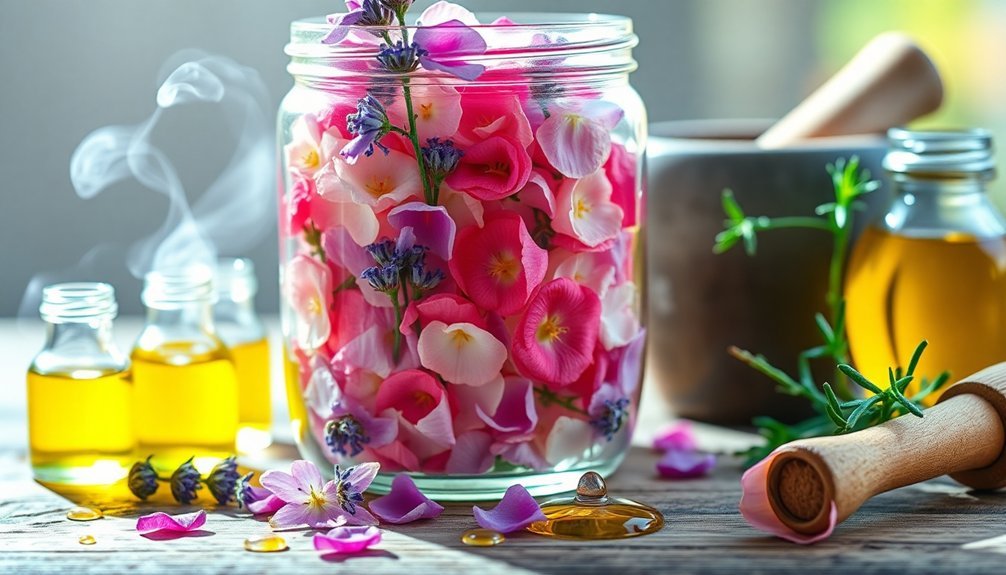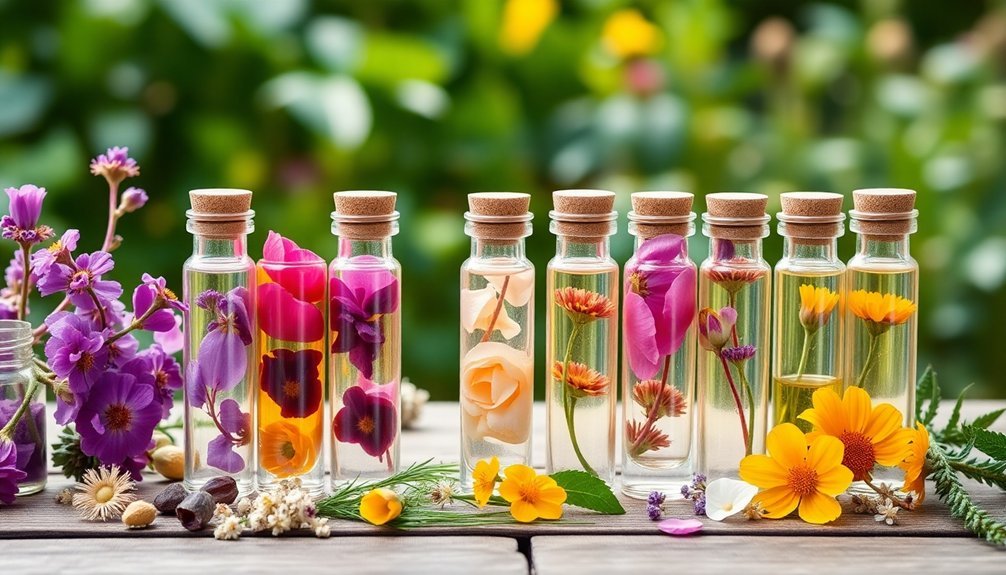You can create your own natural perfume oils at home using several extraction methods, including steam distillation, solvent extraction, enfleurage, or simple maceration. The easiest technique involves infusing flowers in carrier oils like jojoba or sweet almond oil for 2-6 weeks. You'll need dark glass bottles, strainers, and protective gear to get started. Popular flowers like rose, jasmine, and lavender make excellent choices. Mastering these ancient techniques will reveal a world of botanical fragrances.
Understanding Natural Flower Extraction Methods

Getting started with homemade perfume oils requires understanding the key extraction methods that bring out natural flower fragrances. You'll find four main techniques: steam distillation, solvent extraction, enfleurage, and maceration.
Steam distillation works well for lavender and chamomile, preserving delicate compounds while creating hydrosol as a bonus. This method is also recognized as the most affordable option for extracting essential oils.
If you're working with jasmine or rose, you might prefer solvent extraction, though you'll need to be careful about residual chemicals.
For a traditional approach, enfleurage uses odorless fats to capture fragrances from delicate flowers like tuberose and gardenia.
The simplest method, maceration, involves soaking your flowers in carrier oil for several weeks.
Each technique has its strengths – steam distillation's purity, solvent extraction's efficiency, enfleurage's gentleness, and maceration's simplicity.
Essential Tools and Materials for Home Extraction
Now that you understand the extraction methods, let's look at the tools and materials you'll need for your home perfume-making setup.
You'll require a steam distillation apparatus, including a steam generator, condenser, and collection vessel, for the basic extraction process. For storage, dark glass bottles will protect your oils from light damage.
You'll need appropriate solvents like ethanol or carrier oils such as jojoba or sweet almond oil. Don't use olive oil, as its strong scent can interfere with your perfume. Using supercritical CO2 extraction requires specialized equipment and expert knowledge, so it's not recommended for home use.
For safety, always keep protective gear handy – gloves and goggles are essential when handling solvents. Stock up on strainers, thermometers, and airtight containers for the filtering and storage process.
An ultrasonic bath can speed up maceration, though it's optional for beginners.
Step-by-Step Guide to Oil-Based Flower Infusion

Creating fragrant flower-infused oils begins with careful preparation and selecting the right method for your needs.
Start by chopping your dried or wilted flowers, removing stems and excess material. You'll want to use a 1:5 ratio of flowers to oil by volume.
Choose between slow cold infusion for maximum therapeutic properties or a quicker heat method if you're short on time.
For cold infusion, place your flowers in a jar, cover with oil by at least an inch, and let sit for 2-6 weeks. Consider using flowers like lavender and calendula for their healing properties.
For heat methods, use a double boiler or crockpot, maintaining temperatures below 110°F. Keep the lid off to allow moisture to evaporate.
Once infused, strain your oil through cheesecloth or a fine-mesh strainer.
Store in amber bottles in a cool, dark place.
Selecting the Right Flowers for Your Perfume
When crafting your own perfume oils, choosing the right flowers can make the difference between a mediocre and an extraordinary fragrance.
You'll find that each flower brings its unique characteristics and benefits to your creation.
1. Rose: It's the ultimate classic choice, offering a romantic scent that works perfectly as a base note.
You'll love its rich, floral aroma that adds timeless elegance to your perfume.
2. Jasmine: This exotic flower serves as an excellent heart note, providing warm and sensual qualities to your blend.
3. Lavender: Perfect for everyday wear, it offers both therapeutic benefits and a fresh, herbaceous scent.
4. Lily of the Valley and Gardenia: These delicate flowers work wonderfully as top and heart notes, respectively.
While Lily of the Valley brings freshness, Gardenia adds a creamy, sophisticated depth.
Tips for Storing and Preserving Your Flower Extracts

Proper storage and preservation techniques can dramatically extend the life of your flower extracts and protect their delicate fragrances.
Store your extracts in dark amber or cobalt glass bottles with tight-sealing caps to shield them from harmful UV rays and minimize oxidation. Don't use plastic containers, as they can react with your oils and compromise their quality.
Keep your extracts in a cool, dry place away from direct sunlight and heat sources. You'll want to avoid areas with high humidity, like bathrooms.
Remember to label each bottle with the date it was made, and transfer oils to smaller containers as you use them to reduce oxygen exposure.
Always use clean tools when handling your extracts, and check them regularly for any changes in smell or appearance.
With proper care, your flower extracts can last up to two years.
Frequently Asked Questions
How Long Does the Fragrance Typically Last on Skin After Application?
Fragrances typically last 2-8 hours on your skin, depending on your body chemistry, the perfume's concentration, and application method. You'll notice longer wear when you've properly moisturized and applied to pulse points.
Can I Combine Different Extraction Methods for a Single Perfume Blend?
Yes, you can combine oils from different extraction methods to create richer fragrances. Blending steam-distilled lavender with solvent-extracted jasmine, for example, will give you a more complex and well-rounded perfume blend.
What Causes Some Flower Extracts to Turn Brown Over Time?
Your flower extracts turn brown due to enzymatic browning, where polyphenol oxidase enzymes react with phenolic compounds. When you expose them to light, heat, or oxygen, these enzymes trigger oxidation and polymerization reactions.
Are There Specific Seasonal Considerations When Harvesting Flowers for Extraction?
You'll want to harvest flowers during their peak blooming season when their fragrance is strongest. Spring and summer are ideal for most flowers, but you'll need to avoid rainy days and extreme temperatures.
Can Medications Interact With Natural Flower Extracts Applied to Skin?
Yes, you'll need to be careful as flower extracts can interact with medications through skin absorption. They can affect blood thinners, diabetes meds, blood pressure medications, and enhance sedative effects of certain drugs.
In Summary
Now you're ready to create your own signature scents using natural flower extractions at home. Remember to store your perfume oils in dark glass bottles and keep them in a cool, dry place. Don't forget to label each creation with the date and ingredients used. With practice, you'll master the art of natural perfumery and enjoy unique, chemical-free fragrances that you've crafted yourself.





Leave a Reply